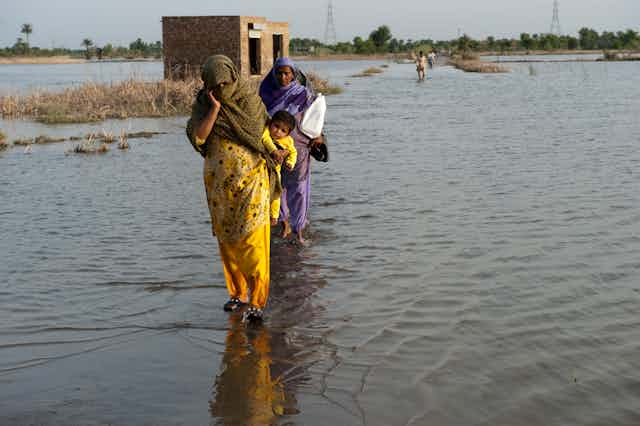More than 6,000 people died and at least 11,000 reportedly disappeared in the aftermath of the destructive flood that hit Libya on September 10 2023.
Infrastructure in north-eastern Libya has been seriously damaged. The economy continues to suffer and companies that are crucial partners for reconstruction and development have been forced to close due to flood damage. With more than 40,000 people still displaced, labour shortages continue and essential services, including healthcare, remain disrupted.
This severe flooding highlighted the vulnerability of Libya – a country already grappling with political instability, ongoing conflict and a deteriorating economy – to climate-related threats.
Libya and other flood-hit countries, especially in conflict zones, could learn a lot from Pakistan, where the plans for recovery from similar floods in 2022 differ in some significant ways.
Pakistan’s response to its floods included a comprehensive post-disaster needs assessment, a strategy that outlines clear priorities for rebuilding livelihoods, agriculture and public infrastructure over the coming five years.
Libya’s approach lacks this forward planning. Without conducting a comprehensive assessment of what a country needs, meaningful recovery efforts cannot be effectively carried out.
The United Nations Sendai framework, a global agreement that guides countries in reducing the risks of natural disasters, emphasises the importance of “building back better” in recovery to reduce vulnerabilities of a place and its people.
However, most disaster management doesn’t focus on long-term recovery. My research in disaster recovery and climate change adaptation indicates that the best route for the development of comprehensive and sustainable plans is for the government and relevant organisations to rebuild affected communities, repair damaged infrastructure and provide ongoing social, economic and health support.
Now that initial response and relief efforts have been rolled out across Libya’s affected regions, the focus needs to shift to consider the long-term recovery of these communities.
The damage of debt
The country also needs to consider how it funds its recovery. Developing countries tend to rely heavily on loans to fund recovery programmes. Countries, including Pakistan, are often forced to continue paying existing loans in the aftermath of disasters instead of spending new funds on recovery.
Pakistan’s journey towards recovery from the major floods of 2010 and 2011 is a stark example of the challenges countries face when burdened with heavy debt. In order to rebuild and rehabilitate, Pakistan borrowed a staggering estimated US$20 billion to US$40 billion. This came at a significant cost.
In 2021, the burden of repaying debts amounted to US$11.9 billion annually accounting for 32% of the Pakistan government’s revenue. Consequently, Pakistan’s capacity to effectively respond to the 2022 floods was severely restricted. Ironically, the country accumulated more debt in addressing the aftermath of these floods than it received in humanitarian support in 2022.
Countries like Libya need to carefully manage their borrowing to avoid long-term economic challenges and debt burdens. Pakistan’s experience showed that private donations from within the country can be a significant source of funds, alongside the international giving that is more common.
Libya could explore alternative funding sources such as international grants, loans from international financial institutions, redirecting existing budget allocations and generating additional revenue domestically through stimulating economic growth.

Road to recovery
There is also a more literal question of how to rebuild. In Pakistan, the reconstruction of damaged roads, bridges, power stations, schools, hospitals and homes involved a collaborative approach. Inspired by the self-resilience housing model developed by Yasmeen Lari, Pakistan’s first female architect, local community involvement was key.
This model also promotes sustainability and generates local employment by using locally sourced materials, such as mud bricks. Instead of relying on conventional and expensive building materials like cement blocks, local people make mud bricks using locally sourced clay and other natural materials that are easily replaceable in the future.
Pakistan’s self-resilience housing approach taps into the benefits of short supply chains and creates local jobs in the process. Libya needs to draw lessons from this strategy for rebuilding infrastructure.

Recovery efforts should not only focus on rebuilding physical infrastructure. Strengthening economic, social and environmental resilience must be prioritised too. As seen in Pakistan, millions of people are still struggling to find a sustainable means of livelihood and clean water remains a pressing issue in many affected areas.
Social and psychological support is just as important. That includes counselling services and mental health systems to address trauma, grief and loss.
A 2022 study by Iranian researchers revealed that post-traumatic stress disorder symptoms were particularly prevalent after extreme flood events. Another 2022 report showed that Pakistan flood survivors who were given professional psychological support recovered more rapidly and completely.
To pave the way for recovery in Libya, additional support will be needed, particularly in terms of temporary shelters, medicine and access to health facilities and sanitation services.
Coordinated local action and stable governance will help fragile regions like Libya and Pakistan to strengthen communities and prepare for more inevitable climate shocks. Peace building needs to be an integral part of climate crisis recovery, prevention and readiness.

Don’t have time to read about climate change as much as you’d like?
Get a weekly roundup in your inbox instead. Every Wednesday, The Conversation’s environment editor writes Imagine, a short email that goes a little deeper into just one climate issue. Join the 30,000+ readers who’ve subscribed so far.

